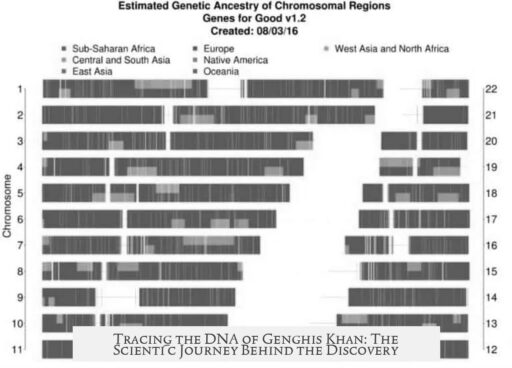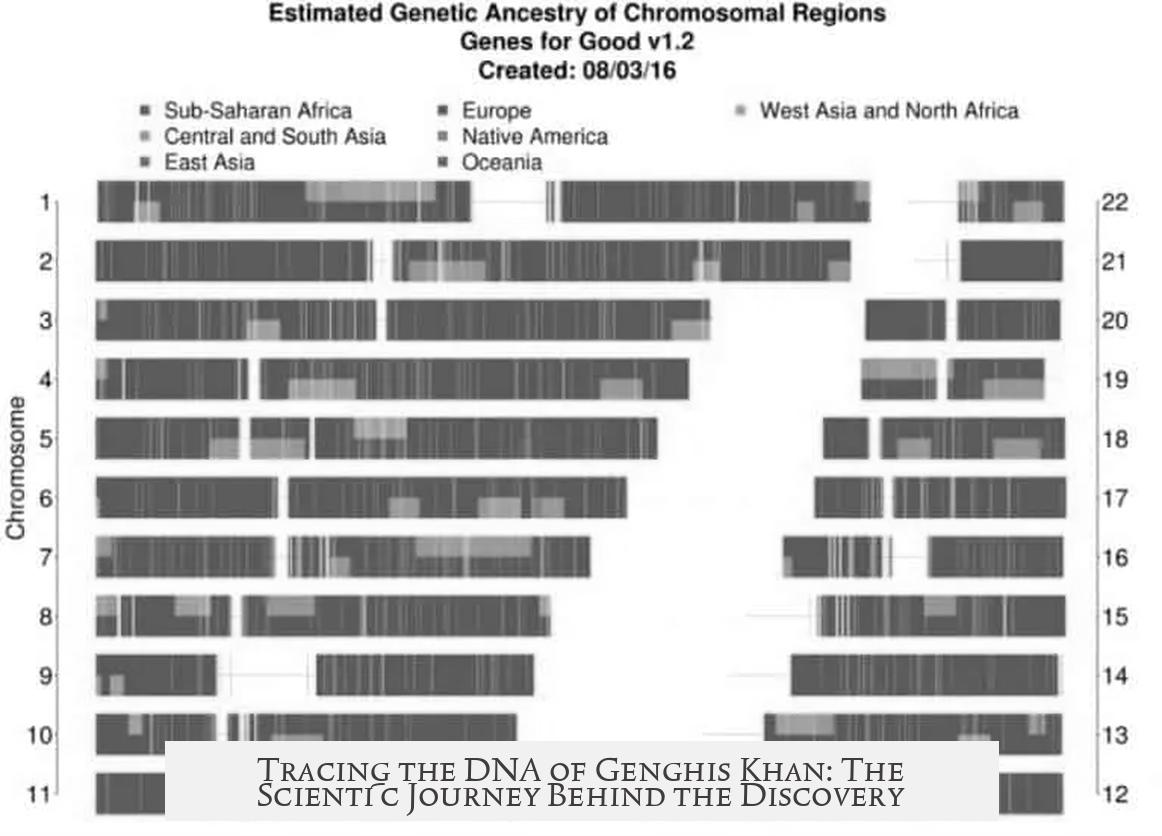Tracing Genghis Khan’s DNA involves complex genetic studies focused on identifying shared paternal lineages across large populations and correlating them with historical data and known descendants. Tatiana Zerjal and colleagues initially identified a genetic lineage in about 8% of men across a vast region of Asia. This lineage’s estimated origin dates back approximately 1,000 years, coinciding roughly with Genghis Khan’s era. However, subsequent research challenges the definitive association of this lineage with Genghis Khan himself.
The initial 2003 study by Zerjal et al., titled “The Genetic Legacy of the Mongols,” analyzed Y-chromosome haplotypes—markers passed from father to son—that appeared at very high frequency stretching from the Ural Mountains through Central Asia, northern China, and into eastern Russia. The unusual geographic spread and frequency suggested the rapid expansion of a male lineage possibly linked to a powerful and prolific ancestor. Based on population models and mutation rates, the team estimated the Time to Most Recent Common Ancestor (TMRCA) to be about 1,000 years ago, fitting the timeline of Genghis Khan’s lifetime.
The discovery ignited significant public and scientific interest, as few historical figures matched the scale and timing needed to explain such widespread genetic influence. This led to popular speculation that the lineage could belong to Genghis Khan, given his known history of fathering many children and founding a vast empire. The lineage was described as a “star cluster” due to its branching pattern consistent with rapid population expansion.
However, more recent research has led to a refinement of these early conclusions. Later studies, such as one freely accessible overview available online, offer a more nuanced analysis incorporating advanced genetic sequencing and better-resolved haplotypes. Modern geneticists obtained the haplotype of a confirmed male-line descendant of Temujin (Genghis Khan), named Batu-Mungke Dayan Khan, identified as C2c1a1a1-M407.
Significantly, this known descendant’s haplotype differs from the one identified by Zerjal’s team. Subsequent refinements suggest that the originally identified “star cluster” lineage is most likely of Kazakh origin rather than directly linked to Genghis Khan himself. This conclusion arose from more precise regional and temporal haplotype comparisons.
The key points leading to this reevaluation include:
- Improved genetic data showing different haplogroup markers in confirmed descendants of Genghis Khan compared to the original “star cluster.”
- Geographical and ethnic distributions of the haplotypes suggesting a Kazakh origin for the high-frequency lineage identified initially.
- Population genetic models incorporating migration, mutation rates, and historical records supporting the decoupling of Zerjal’s lineage from Genghis Khan’s direct male line.
Understanding the distribution of Genghis Khan’s genetic legacy also involves appreciating the mathematics of ancestry. Genghis Khan lived approximately 35 generations ago. By simple exponential mathematics, a modern person would theoretically have more ancestors at that time than the number of people alive globally, often cited as around 30 billion ancestors. This apparent paradox arises because individuals can appear multiple times in a family tree. Consequently, many people alive today could descend from Genghis Khan simply due to genealogical proliferation over centuries.
Therefore, while anyone with ancestors alive in the late 12th century likely has numerous descendants now, this fact alone does not uniquely trace a lineage back to him. The broad genetic legacy expected of a prolific ancestor like Genghis Khan would produce multiple lineages that might diffuse across populations.
In summary, the initial trace of a widespread Y-chromosome haplotype led researchers to hypothesize a connection to Genghis Khan. However, more genetic data from confirmed male-line descendants and detailed haplotype assessments have refuted this direct association. Instead, the identified haplotype likely originates from a prominent Central Asian lineage of Kazakh provenance, not Genghis Khan himself. The wide presence of this haplotype still reflects the complex history of human migration and expansion across Asia during the last millennium.
The process to trace Genghis Khan’s DNA exemplifies the challenges in linking historical figures to genetic data. It relies on combining genetics, history, archaeology, and population modeling.
| Aspect | Details |
|---|---|
| Initial Discovery | Shared Y-chromosome haplotype in ~8% men from Ural to eastern Asia; ~1,000 years old. |
| Initial Interpretation | Hypothesized to be Genghis Khan’s lineage based on timing and geographic spread. |
| Known Descendant Haplotype | C2c1a1a1-M407 for Batu-Mungke Dayan Khan (confirmed male-line descendant). |
| Revised Origin | Star cluster lineage likely Kazakh; not Genghis Khan’s direct line. |
| Ancestry Complexity | Modern individuals have billions of ancestors 35 generations ago; genealogy overlaps. |
- Y-chromosome studies identified a major lineage across Asia dating ~1,000 years ago.
- Early speculation linked this lineage to Genghis Khan due to distribution and timing.
- Genetic evidence from confirmed descendants shows different haplotypes than initially thought.
- The initially identified lineage is now linked to Kazakh origins, not Genghis Khan.
- Genealogical math explains why many people today likely descend from historical figures like Genghis Khan, complicating lineage tracing.



